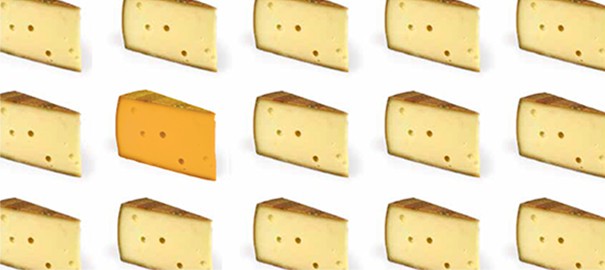
Months ago international cheese consultant Ivan Larcher surprised me with this response when I asked what trends he was seeing in the cheese industry: “What I’ve been seeing is that everybody tends to use the same starter cultures. In the United States, Quebec, England, Sweden, or even Northern Africa, they’re using the same starters, and the main consequence is that the final products tend to lose their diversity.” Hearing this, I feared that cheese cultures—the microbes added to milk to develop the flavor and texture of cheese curd—were headed in the direction of heirloom seeds; as uncommon varieties die out, biodiversity is lost. The reality, however, is slightly different and, as always, a bit more complicated.
Generations ago, cheesemakers either made their own starter cultures from whey or from a mother culture they’d cultivated, or they added no culture at all—simply allowing bacteria from the environs to take their course. Both of these practices are difficult to control, and they often led to haphazard results. Today, while some producers continue to make their own cultures, most cheesemakers operating on a large scale, and even many of the artisan and hobbyist ranks, too, are using commercial cultures available in freeze-dried powder form or frozen pellets.
There have been advantages to this, as Alyce Birchenough, veteran cheesemaker and owner of Sweet Home Farm in Alabama, points out, “Advances in culture technology is one of the reasons that commercial cheesemaking has become more accessible.” Commercially produced cultures offer more control in cheesemaking and reduced risk of both failed and inconsistent batches, as well as contamination.
Dave Potter, owner of The Dairy Connection, a culture distribution company, has worked in the industry for over 30 years. Over that time, he says, there have been massive consolidations among the companies that propagate and bank cheese cultures. During consolidations, bacteria strain banks are reduced when there are genetically identical strains that each company markets under different names. The result is fewer products available on a commercial scale but not necessarily a reduction of biodiversity.
Over the past few decades, the landscape of cheesemaking has evolved toward the consolidation of small creameries to form large-scale operations focused on more commercial cheeses. This has created a shift in the demand for cultures. The primary needs of a large-scale cheesemaker are to use cultures that reduce the risk of bacteriophage (a virus that kills off starter cultures, rendering them ineffective and ruining entire vats of milk), increase productivity, and ensure a consistent final product. Culture companies have responded to the large-scale cheesemaker priorities by selecting for more vigorous strains that have mechanisms to resist bacteriophage and that build acid, the primary function of starter cultures, more quickly. As a result, widely available starter cultures are generally building acid much faster.
Faster starters are a cost-effective means for reducing the time it takes to make cheese (think five-hour commodity cheddar now made in three hours). However, this new timetable does not suit every cheesemaking recipe. There are traditional cheeses that require a slow build of acid to achieve specific textures and flavors, Banon and traditional English Cheddars, for instance.
So what’s a smaller cheesemaker to do? Producers can adopt a DIY approach, but many are hesitant to take on the additional risks inherent in growing their own cultures. Cheese consultant Peter Dixon will teach clients how to make their own starters but emphatically states, “On a small scale you’ve got to be just as careful making your own cultures as you are making your cheese. Just like developing a food safety plan for cheesemaking, you’ve got to make one for culture production.”
Producers can also contract with a university or a culture house to harvest bacteria naturally occurring within their landscape and propagate them to see if they would make functional cheesemaking cultures. But this process can be quite costly and won’t necessarily yield a viable culture.
While both Potter and Dixon agree that the variety of cultures readily available to the full range of cheesemakers has decreased, neither was convinced that this change would cause a loss of diversity in cheese types and flavors. There are too many other variables, they say, at play in cheesemaking. As Dixon points out, “The advantage that the small-batch producer has—particularly farmstead—is the milk itself.” Even if small producers continue to use common cultures, they have a unique milk supply. And then of course, there’s individual technique. How a cheesemaker applies a culture—dosage, temperature, time, and process—all impact the final product. Cultures may indeed be more standardized, but the artisans using them are not. For that we can be very glad.




